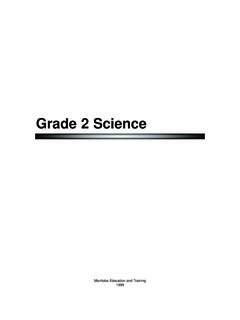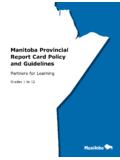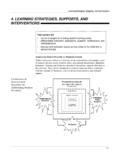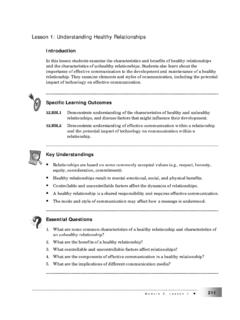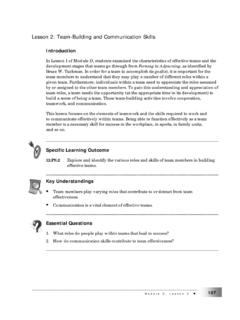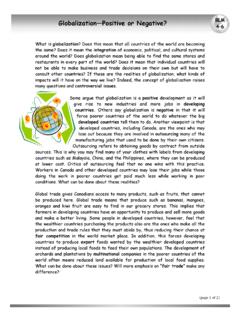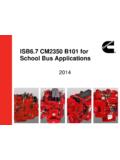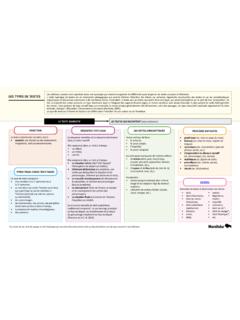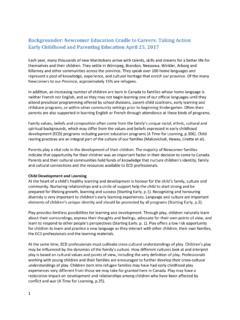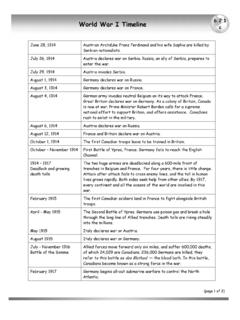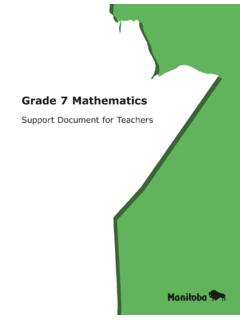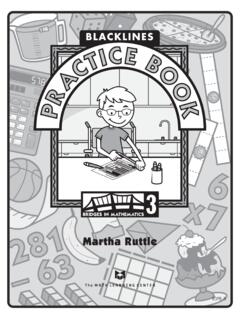Transcription of Grade 5 Mathematics Support Document for Teachers
1 Grade 5 Mathematics Support Document for TeachersGr A d E5 MA t h E M A t i c ssupport Document for teachers2014 Manitoba Education and Advanced LearningManitoba Education and Advanced Learning Cataloguing in Publication DataGrade 5 Mathematics [electronic resource] : Support Document for teachersIncludes bibliographical referencesISBN: 978-0-7711-5901-51. Mathematics Study and teaching (Elementary).2. Mathematics Study and teaching (Elementary) Manitoba. Manitoba Education and Advanced 2014, the Government of Manitoba, represented by theMinister of Education and Advanced Learning. Manitoba Education and Advanced LearningSchool Programs DivisionWinnipeg, Manitoba, CanadaEvery effort has been made to acknowledge original sources and to complywith copyright law. If cases are identified where this has not been done,please notify Manitoba Education and Advanced Learning. Errors oromissions will be corrected in a future edition.
2 Sincere thanks to theauthors, artists, and publishers who allowed their original material to beused. All images found in this Document are copyright protected and should notbe extracted, accessed, or reproduced for any purpose other than for theirintended educational use in this websites referenced in this Document are subject to change. Educatorsare advised to preview and evaluate websites and online resources beforerecommending them for student use. Available in alternate formats upon copies of this resource can be purchased from theManitoba Text Book Bureau (stock number 80634). Order onlineat < >. This resource is also available on the Manitoba Education andAdvanced Learning website at < >. co n t E n t sList of blackline Masters (BLMs)vGrade 5 Mathematics blackline MastersvGrades 5 to 8 Mathematics blackline MastersviiiAcknowledgementsixIntroductio n1 Overview2 Conceptual Framework for Kindergarten to Grade 9 Mathematics6 Assessment10 Instructional Focus12 Document Organization and Format13 Number1 Number ( )3 Number ( )19 Number ( )31 Number ( )51 Number ( )67 Number ( )85 Number ( )99 Number ( , )117 Number ( )131 Number ( )141 Patterns and Relations1 Patterns and Relations (Patterns) ( )3 Patterns and Relations (Variables and Equations) ( )17iiic o n t e n t sShape and Space1 Shape and Space (Measurement) ( )3 Shape and Space (Measurement) ( )15 Shape and Space (Measurement) ( )31 Shape and Space (Measurement) ( )43 Shape and Space (3-D Objects and 2-D Shapes) ( )55 Shape and Space (3-D Objects and 2-D Shapes) ( )69 Shape and Space (Transformations) ( )
3 81 Statistics and Probability1 Statistics and Probability (Data Analysis) ( , )3 Statistics and Probability (Chance and Uncertainty) ( , )19 Appendices1 Bibliography1G r a d e 5 M a t h e m a t i c s : s u p p o r t d o c u m e n t f o r te a c h e r sivc o n t e n t svList of blackline Masters (BLMs) Grade 5 Mathematics blackline MastersNumber (N)BLM : Place ValueBLM : Place Value HeadingsBLM : Which Do You Prefer Chunky or Smooth?BLM : Situation CardsBLM : Estimation SituationsBLM : Tic-Tac-Toe GridsBLM : Division PuzzleBLM : Everyone CardsBLM : Single Digit Multiplication ChartBLM : Race around the ClockBLM : Multiplication ProblemsBLM : Game SheetBLM : ProductsBLM : Multiplication MethodBLM : Division Problem CardsBLM : Division Playing BoardBLM : Equivalent Fraction CardsBLM : Fraction CardsBLM : Recording SheetBLM : Decimal Equivalent CardsBLM : Decimal Recording SheetBLM : Decimal CardsBLM : Number FramesBLM : Decimal ActivityPatterns and Relations (PR)BLM : Pattern Problem 1 BLM : Pattern Problem 2 BLM : Pattern Problem 3 BLM : Pattern Problem 4 BLM : Pattern ActivityBLM : Equation ProblemBLM : Equation ActivityBLM : Word ProblemsBLM : Equation ActivityShape and Space (SS)BLM : Perimeter and Area Recording SheetBLM : Assessing Prior KnowledgeBLM : Measurement ActivityBLM : Line CardsBLM.
4 Measurement CardsBLM : Measurement TableBLM : Line SegmentsBLM : I Have, Who Has ..?BLM : Volume ActivityBLM : Capacity ProcedureBLM : Quadrilateral Name CardsBLM : Quadrilateral CardsBLM : Quadrilateral Activity SheetBLM : Reflection Activity SheetBLM : Transformation CardsStatistics and Probability (SP)BLM : Prior KnowledgeBLM : First- and Second-Hand DataBLM : Candy GraphBLM : Probability Label CardsBLM : Probability ActivityBLM : Spinner StatementsBLM : ExperimentBLM : Mystery SpinnerG r a d e 5 M a t h e m a t i c s : s u p p o r t d o c u m e n t f o r te a c h e r svic o n t e n t sviiGrades 5 to 8 Mathematics blackline MastersBLM 5 : Observation FormBLM 5 : Concept Description Sheet #1 BLM 5 : Concept Description Sheet #2 BLM 5 : How I Worked in My GroupBLM 5 : Number CardsBLM 5 : Blank Hundred SquaresBLM 5 : Place-Value Chart Whole NumbersBLM 5 : Mental Math StrategiesBLM 5.
5 Centimetre Grid PaperBLM 5 : Base-Ten Grid PaperBLM 5 : Multiplication TableBLM 5 : Fraction BarsBLM 5 : Clock FaceBLM 5 : SpinnerBLM 5 : Thousand GridBLM 5 : Place-Value Mat Decimal NumbersBLM 5 : Number FanBLM 5 : KWL ChartBLM 5 : Double Number LineBLM 5 : Algebra TilesBLM 5 : Isometric Dot PaperBLM 5 : Dot PaperBLM 5 : Understanding Words ChartBLM 5 : Number LineBLM 5 : My Success with Mathematical ProcessesBLM 5 : Percent CircleA c k n o w l e d g e m e n t sixAc k n o w L E d G E M E n t sManitoba Education and Advanced Learning wishes to thank the members of the Grades 5 to 8 Mathematics Support Document Development Team for their contribution to this dedication and hard work have made this Document JohnsUniversity of ManitobaGrade 5 to Grade 8 Mathematics SupportDocument DevelopmentTeam (2006 2008)Heidi HolstLord Selkirk School DivisionLinda GirlingLouis Riel School DivisionDarlene WillettsEvergreen School DivisionHolly ForsythFort La Bosse School DivisionChris HarbeckWinnipeg School DivisionSteven HuntSt.
6 Gerard SchoolJan JebsenKelsey School DivisionDianna KicenkoEvergreen School DivisionKelly KuzykMountain View School DivisionJudy MaryniukLord Selkirk School DivisionGreg SawatzkyHanover School DivisionManitoba Education andAdvanced Learning School ProgramsDivision StaffHeather AndersonConsultant(until June 2007)Development UnitInstruction, Curriculum and Assessment BranchCarole BilykProject ManagerDevelopment UnitInstruction, Curriculum and Assessment BranchLee-Ila BotheCoordinatorDocument Production Services UnitEducational Resources BranchLinda GirlingProject Leader(since January 2011)Development UnitInstruction, Curriculum and Assessment BranchLynn HarrisonDesktop PublisherDocument Production Services UnitEducational Resources BranchHeather Knight WellsProject Leader(until December 2010)Development UnitInstruction, Curriculum and Assessment BranchGrant MoorePublications EditorDocument Production Services UnitEducational Resources Branchin t r o d u c t i o nPurpose of the documentGrade 5 Mathematics : Support Document for Teachersprovides various instructionalactivities, assessment strategies, and learning resources that promote the meaningfulengagement of Mathematics learners in Grade 5.
7 The Document is intended to be used asan aid to Teachers as they work with students in achieving the prescribed outcomes andachievement indicators identified in Kindergarten to Grade 8 Mathematics : ManitobaCurriculum Framework of Outcomes (2013)(Manitoba Education).BackgroundKindergarten to Grade 8 Mathematics : Manitoba Curriculum Framework of Outcomesis basedon The Common Curriculum Framework for K 9 Mathematics , which resulted from ongoingcollaboration with the Western and Northern Canadian Protocol (WNCP). In its work,WNCP emphasizes ncommon educational goalsnthe ability to collaborate and achieve common goalsnhigh standards in educationnplanning an array of educational activitiesnremoving obstacles to accessibility for individual learnersnoptimum use of limited educational resourcesThe growing effects of technology and the need for technology-related skills havebecome more apparent in the last half century. Mathematics and problem-solving skillsare becoming more valued as we move from an industrial to an informational a result of this trend, Mathematics literacy has become increasingly connections between mathematical study and daily life, business, industry,government, and environmental thinking is imperative.
8 The Kindergarten to Grade 12 Mathematics curriculum is designed to Support and promote the understanding thatmathematics isna way of learning about our worldnpart of our daily livesnboth quantitative and geometric in naturei n t r o d u c t i o n1 OverviewBeliefs about students and Mathematics LearningThe Kindergarten to Grade 8 Mathematics curriculum is designed with theunderstanding that students have unique interests, abilities, and needs. As a result, it isimperative to make connections to all students prior knowledge, experiences, are curious, active learners with individual interests, abilities, and needs. Theycome to classrooms with unique knowledge, life experiences, and backgrounds. A keycomponent in successfully developing numeracy is making connections to thesebackgrounds and experiences. Students learn by attaching meaning to what they do, and need to construct their ownmeaning of Mathematics . This meaning is best developed when learners encountermathematical experiences that proceed from the simple to the complex and from theconcrete to the abstract.
9 The use of manipulatives and a variety of pedagogicalapproaches can address the diversity of learning styles and developmental stages ofstudents. At all levels, students benefit from working with a variety of materials, tools,and contexts when constructing meaning about new mathematical ideas. Meaningfulstudent discussions can provide essential links among concrete, pictorial, and symbolicrepresentations of Mathematics . Students need frequent opportunities to developand reinforce their conceptual understanding,procedural thinking, and problem-solving addressing these three interrelated components,students will strengthen their ability to applymathematical learning to their daily lives. The learning environment should value and respectall students experiences and ways of thinking, sothat learners are comfortable taking intellectualrisks, asking questions, and posing need to explore problem-solvingsituations in order to develop personal strategiesand become mathematically literate.
10 Learners mustrealize that it is acceptable to solve problems indifferent ways and that solutions may understanding:comprehending mathematicalconcepts, relations, and operationsto build new knowledge. (Kilpatrick,Swafford, and Findell 5)Procedural thinking: carrying outprocedures flexibly, accurately,efficiently, and solving: engaging inunderstanding and resolvingproblem situations where a methodor solution is not immediatelyobvious. (OECD 12)G r a d e 5 M a t h e m a t i c s : s u p p o r t d o c u m e n t f o r te a c h e r s2 First nations, M tis, and inuit PerspectivesFirst Nations, M tis, and Inuit students in Manitoba come from diverse geographic areaswith varied cultural and linguistic backgrounds. Students attend schools in a variety ofsettings including urban, rural, and isolated communities. Teachers need to recognizeand understand the diversity of cultures within schools and the diverse experiences ofstudents.
